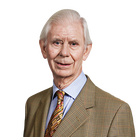Photojournalism can become a form of art
Images are the testimony which the victims of cruel civil war often want the rest of us to see

I saw more deeply into the nature of news photography the other evening by listening to one of the world's greatest exponents. James Nachtwey of Time magazine was responding to questions from a packed meeting of fellow professionals. Around 500 people were crowded together in the main lecture hall of the Royal Geographical Society in London. First, a documentary was shown on Nachtwey's work, itself nominated for an Oscar. Then Nachtwey spoke, and very freely.
I value news photography in all its aspects. In certain situations, pictures convey more than words can. Nachtwey specialises in the most difficult work: combat situations. He has covered Afghanistan, Bosnia, Kosovo, El Salvador and Rwanda. If a conflict starts in Iraq, I hope he will be there.
"I am a workman who works with other colleagues," Nachtwey said. Journalism is a trade or a craft, whether in its written or pictorial form. Wasn't Nachtwey, however, tempting fate in these dangerous situations? "It's what is required." And this means that you don't recoil. Nachtwey recounted how once in El Salvador, when he was starting out, he saw something horrible. Instinctively, he turned away to leave. Then he stopped, turned, and went back...
"It was my duty. We are not there to baby ourselves emotionally. If you are going to be a witness, you really have to be a witness." Moreover, it is this testimony that the victims of cruel civil war often want. They wish their distress to be conveyed to the world at large.
How does this work? A member of the audience said he felt a sort of frustrated powerlessness when he saw a Nachtwey picture. At least, came the reply, it made you feel like doing something. "Now it is up to you to decide what to do. Don't turn away from your feelings." At some point you will have a discussion with somebody. Keep the sentiment alive. Even the people who make the decisions see the same pictures and know that millions will be upset by them. As it happened, I had been perturbed by a photograph in Friday's newspapers. It showed an unnamed, murdered woman being dragged away from the Chechen hostage-taking in Moscow as if she were no more than a bag of heavy laundry.
By now it must be obvious that if Nachtwey is merely a workman, he is an extraordinary one. He was asked what he felt when he was operating in the middle of death and destruction. Do you suppress your feelings and concentrate solely on the job in hand? I was astonished by his reply: "It's all about emotions. The emotions are the source of the image. The emotions are why you went there in the first place. You can't make a picture which moves somebody else unless you yourself have been moved."
Nachtwey discussed two particular emotions. Do you feel anger, he was asked. "Anger might be the main fuel of my work. Outrage. Disbelief that this can possibly be allowed to be happening." Do the intentions of the photographer matter? "The intentions are very, very important. It's not meant to be neutral. It's meant to move you in a certain way. I photograph a lot of inhuman occurrences. But I always want there to be a human element in the picture. At the core of it, I want there to be a sense of compassion. I truly hope you perceive that intention."
Emotions as the source of the image, anger and compassion – these are not the words of a mere humble worker or craftsman, these are the sentiments of an artist. Indeed, I believe that journalism is one of those crafts that can occasionally rise to the level of art – as, say, furniture-making can and as plumbing can not. Nachtwey was having none of this. He denied the artistic impulse.
"I am not intending to create art but rather to create a profound human communication... I suppose sometimes it might become art. It's not my reason for being a photographer. I am a photographer for the mass media first and foremost. I take pictures to create public awareness and from consciousness grows conscience."
Later, the question was put again in a more potent form. Is there not a contradiction between the obvious beauty of your pictures and the obvious horror of the scenes they are depicting and the messages they are sending?
"I'm not sure that there is anything beautiful about a starving man. I try to make a picture that is eloquent, powerful, that will reach people very directly, not filtered through too many artistic devices, and is accessible.
"If there is beauty there, it is not the beauty that I made; it is beauty that exists. Maybe seeing beauty and also recognising the suffering makes the suffering more accessible to you." With these words, the evening ended.
Nachtwey's approach to his task shows, I think, how the great practitioners always transcend their métier. He knows all that can be known about the techniques of news photography, as others do; he takes care to supervise minutely the printing of his images; he has learnt how to conduct himself in a war zone and how to judge the ratio between getting the job done and surviving. These things war photographers must understand. But Nachtwey adds an unwearying commitment, a crusading spirit and a clear moral purpose. These optional extras, so to speak, make all the difference.

Join our commenting forum
Join thought-provoking conversations, follow other Independent readers and see their replies